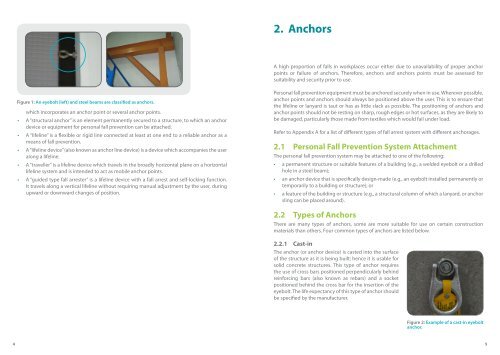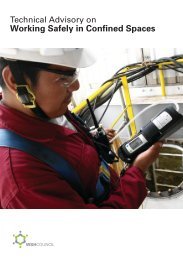HERE - Workplace Safety and Health Council
HERE - Workplace Safety and Health Council
HERE - Workplace Safety and Health Council
You also want an ePaper? Increase the reach of your titles
YUMPU automatically turns print PDFs into web optimized ePapers that Google loves.
2. AnchorsA high proportion of falls in workplaces occur either due to unavailability of proper anchorpoints or failure of anchors. Therefore, anchors <strong>and</strong> anchors points must be assessed forsuitability <strong>and</strong> security prior to use.Figure 1: An eyebolt (left) <strong>and</strong> steel beams are classified as anchors.which incorporates an anchor point or several anchor points.• A “structural anchor” is an element permanently secured to a structure, to which an anchordevice or equipment for personal fall prevention can be attached.• A “lifeline” is a flexible or rigid line connected at least at one end to a reliable anchor as ameans of fall prevention.• A “lifeline device” (also known as anchor line device) is a device which accompanies the useralong a lifeline.• A “traveller” is a lifeline device which travels in the broadly horizontal plane on a horizontallifeline system <strong>and</strong> is intended to act as mobile anchor points.• A “guided type fall arrester” is a lifeline device with a fall arrest <strong>and</strong> self-locking function.It travels along a vertical lifeline without requiring manual adjustment by the user, duringupward or downward changes of position.Personal fall prevention equipment must be anchored securely when in use. Wherever possible,anchor points <strong>and</strong> anchors should always be positioned above the user. This is to ensure thatthe lifeline or lanyard is taut or has as little slack as possible. The positioning of anchors <strong>and</strong>anchor points should not be resting on sharp, rough edges or hot surfaces, as they are likely tobe damaged, particularly those made from textiles which would fail under load.Refer to Appendix A for a list of different types of fall arrest system with different anchorages.2.1 Personal Fall Prevention System AttachmentThe personal fall prevention system may be attached to one of the following:• a permanent structure or suitable features of a building (e.g., a welded eyebolt or a drilledhole in a steel beam);• an anchor device that is specifically design-made (e.g., an eyebolt installed permanently ortemporarily to a building or structure); or• a feature of the building or structure (e.g., a structural column of which a lanyard, or anchorsling can be placed around).2.2 Types of AnchorsThere are many types of anchors, some are more suitable for use on certain constructionmaterials than others. Four common types of anchors are listed below.2.2.1 Cast-inThe anchor (or anchor device) is casted into the surfaceof the structure as it is being built; hence it is usable forsolid concrete structures. This type of anchor requiresthe use of cross bars positioned perpendicularly behindreinforcing bars (also known as rebars) <strong>and</strong> a socketpositioned behind the cross bar for the insertion of theeyebolt. The life expectancy of this type of anchor shouldbe specified by the manufacturer.Figure 2: Example of a cast-in eyeboltanchor.4 5
















